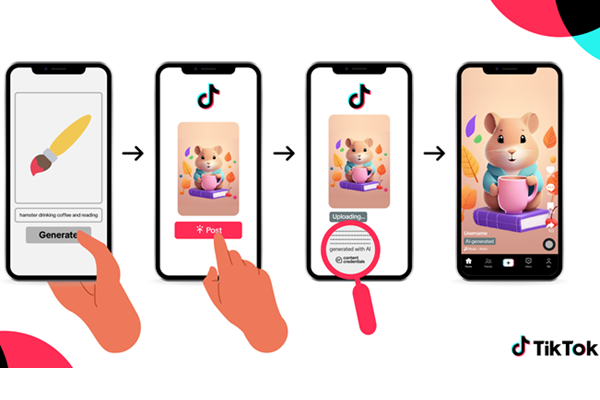TikTok Starts Automatically Labeling AI-Produced Synthetic Media
 TikTok has begun rolling out a new feature to recognize and label content created with generative AI automatically. This Content Credentials tool comes out of TikTok’s new partnership with the Coalition for Content Provenance and Authenticity (C2PA) and is part of a larger strategy by the social media video platform to reduce misinformation and boost transparency related to what it refers to as AI-generated content (AIGC).
TikTok has begun rolling out a new feature to recognize and label content created with generative AI automatically. This Content Credentials tool comes out of TikTok’s new partnership with the Coalition for Content Provenance and Authenticity (C2PA) and is part of a larger strategy by the social media video platform to reduce misinformation and boost transparency related to what it refers to as AI-generated content (AIGC).
TikTok Takes AI to Task
TikTok’s Content Credentials work by embedding metadata into digital content uploaded from some external platforms. There’s already a similar labeling service for any “realistic” synthetic media produced on TikTok, which the company claims has been used by more than 37 million creators. The new system works for when people upload a video or image to TikTok, spotting synthetic content and slapping a label naming it as such, as seen in the image above. The tool currently reviews images and videos, but it is expected to be extended to audio content soon.
The Content Credentials allow for a traceable digital history of content, showing when, where, and how it was created or edited. This metadata remains with TikTok content even when downloaded, enabling anyone to verify the authenticity of the content using C2PA’s tools. Additionally, TikTok has joined the Adobe-led Content Authenticity Initiative (CAI), reinforcing its dedication to content transparency. While the initial rollout of auto-labeled AIGC on TikTok may be limited, as it requires the presence of Content Credentials, widespread implementation across various platforms is anticipated to increase the scope of labeled content.
Similar movements are underway on other social media platforms. For instance, YouTube requires that users disclose when they use generative AI to create deepfakes or other media that could be mistaken for reality. YouTube’s parent company, Google, has mandated such disclosures on political ads this year, while OpenAI published a whole strategy guide to how it is working to prevent misuse of its tech during the election.
“AI enables incredible creative opportunities, but can confuse or mislead viewers if they don’t know content was AI-generated,” TikTok explained in a blog post. “Over the coming months, we’ll also start attaching Content Credentials to TikTok content, which will remain on content when downloaded. That means that anyone will be able to use C2PA’s Verify tool to help identify AIGC that was made on TikTok and even learn when, where and how the content was made or edited. Other platforms that adopt Content Credentials will be able to automatically label it.”
This doesn’t mean TikTok is pulling back on its own generative AI projects, including testing a generative AI chatbot named Tako, a synthetic image generator for user avatars as part of its custom digital avatar feature, The company also offers a text-to-image AI Greenscreen filter for translating text prompts into background images.
Beyond the AI content labels, TikTok is also introducing new media literacy resources developed with expert input from organizations like MediaWise and WITNESS. The idea is to educate TikTok’s community on how to interpret and critically assess AI-generated content and potential misinformation. With TikTok’s current precarious legal status in the U.S., after Congress passed bills to try and force its parent company, ByteDance, to sell to a U.S.-based company, anything TikTok can do to make itself look better to the public is likely being pursued. TikTok also plans to release a series of videos that will explain the role and significance of AIGC labels in contextualizing content. The platform’s policies already strictly prohibit misleading AI-generated content, whether labeled or not.
Follow @voicebotaiFollow @erichschwartz
YouTube Starts Requiring AI and Deepfake Disclosure in Videos








